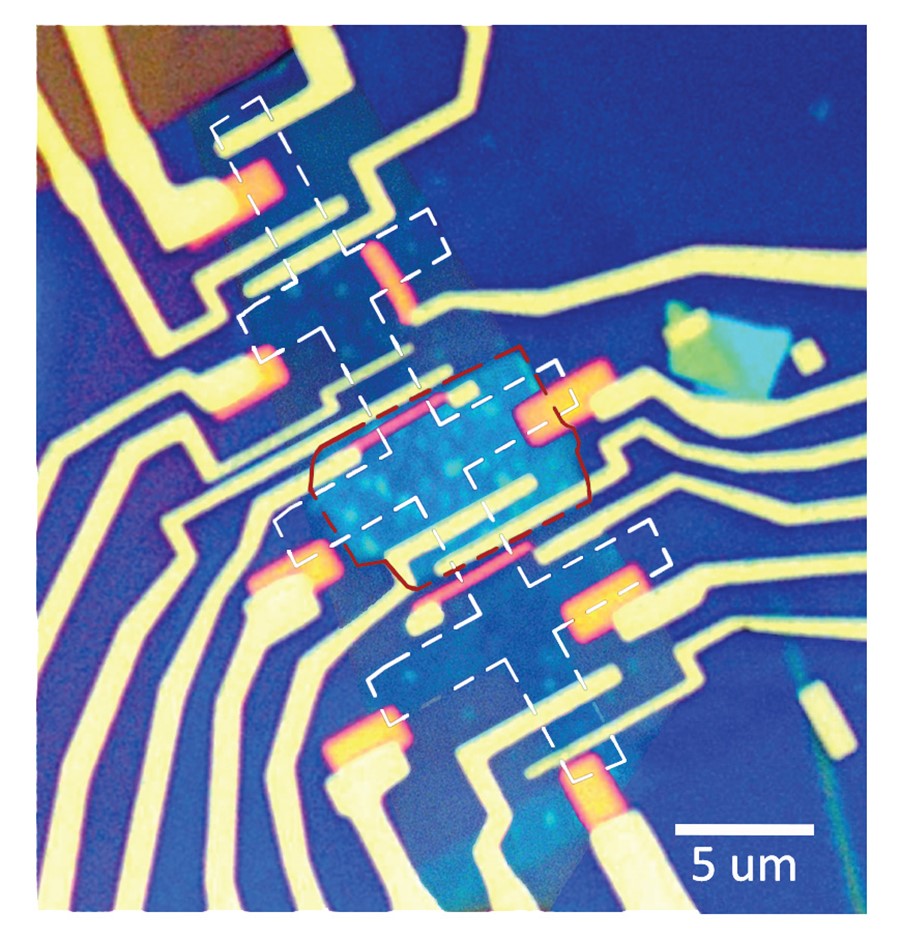Layered heterostructures put a spin on magnetic memory devices
Interfacing graphene with layers of transition metal dichalcogenides enables electric field-controlled spintronic memory devices.

Graphene is a unique material with great potential for the long-distance transportation of spin information. However, spin-to-charge interconversion (SCI) in graphene and graphene-based heterostructures to date could not be performed at room temperature. But now, researchers at Graphene Flagship partners ICN2 and Universitat Autònoma de Barcelona, Spain, and the University of Groningen, the Netherlands, have achieved efficient room temperature SCI in graphene-based structures, and devised a way to make this process tuneable using an external electric field. The findings, published in Nature Materials and Nano Letters, could allow scientists to use layered heterostructures for ultra-compact, low-power consumption magnetic memory devices.
Spintronics is a branch of electronics which uses electrons' spin to store, manipulate and transfer information. Spintronics could benefit many emerging markets, like motion sensing and next-generation memory devices. Developing efficient and versatile spin-based technologies requires both high-quality materials for long-distance spin transfer, and suitable engineering methods to generate and manipulate spin currents, to ensure electrons move in a controlled way with their spins oriented along a given direction.
Generally, spin currents are generated and detected using ferromagnetic contacts. But as an alternative, spin-orbit interactions could enable spin currents to be controlled entirely by an electric field, resulting in a far more versatile tool to be implemented in large-scale spin devices. Now, Graphene Flagship researchers ICREA Prof. Sergio O. Valenzuela, ICREA Prof. Stephan Roche, and colleagues have exploited the unique spin properties of graphene to transport spin information across long distances in large-scale SCI electronics. Additionally, by interfacing graphene with transition metal dichalcogenides (TMDs), another family of layered materials with strong spin-orbit coupling, they were able to precisely control spin transport in these devices. "Thanks to this research, the Graphene Flagship's Spintronics Work Package has made a major step towards the engineering of SCI in quantum devices, with genuine potential for spintronics applications," explains Roche.
By fabricating a high-quality device and using very sensitive detection techniques to evaluate the spin Hall and inverse spin Galvanic effects – focusing in particular on spin precession and non-local measurements – they demonstrated experimentally that the SCI in graphene–TMD heterostructures is in good agreement with theoretical models. Furthermore, using these techniques, Graphene Flagship researchers not only demonstrated the spin-related character of the signals, but also tailored the efficiency of their SCI and sign using electrostatic gating. This important feature directly showcases their ability to manipulate spin information in the heterostructures with an electric field, and this could soon lead to new applications in magnetic memory devices. Most notably, they found that the room temperature SCI efficiencies were just as high as the best results using other materials.
"We're very excited to report the first unambiguous evidence of large and tuneable SCI in van der Waals heterostructures at room temperature," comments Valenzuela, from Graphene Flagship partner ICN2. "This is a significant step forward towards the long sought-after goal of electrostatic control of spin information," he continues. Additionally, Prof. Bart van Wees, from Graphene Flagship partner the University of Groningen, elaborates: "It is difficult to imagine how complex it is to fabricate spin devices combining various types of magnetic and non-magnetic materials, graphene, boron nitride, and strong spin-orbit coupling materials such as TMDs. Thanks to this work, the Spintronics Work Package has developed a unique expertise in realizing operational spin devices which really show the full potential of layered materials."
Kevin Garello, Graphene Flagship Work Package Leader for Spintronics, comments: "Devices involving the spin–orbit torque phenomenon, such as the spin Hall effect and the spin Galvanic effect, are great candidates for future spintronics applications as they require low power input and are capable of ultra-fast performance. It is great to see that spin-orbit torques can be electrically manipulated and improved by the smart engineering of layered materials, which has now been unequivocally confirmed independently by two experimental teams in Work Package Spintronics. This opens the door for new and exciting perspectives and strategies to manipulate spin information and further advance applications in spintronics based on layered materials."
The success of these studies is the result of the joint effort between experimental and theoretical researchers working closely together in the EU-funded Graphene Flagship framework. The results provide valuable insights for the spintronics and layered materials communities, and the researchers hope that their findings will enable scientists to explore new theoretical models and further experiments in the future.
Andrea C. Ferrari, Science and Technology Officer of the Graphene Flagship and Chair of its Management Panel, adds: "The Graphene Flagship has invested in spintronics research since the very beginning. The great potential of graphene and related materials in this area has been showcased by world-leading work done in the Flagship. These results indicate that we are getting close to the point where the fundamental work can be translated into useful applications, as foreseen in our science and technology and innovation roadmaps."
References
- 'Tunable room-temperature spin galvanic and spin Hall effects in van der Waals heterostructures,' Nat. Mater. (2020) doi:10.1038/s41563-019-0575-1 . L. Antonio Benítez, Williams Savero Torres, Juan F. Sierra, Matias Timmermans, Jose H. Garcia, Stephan Roche, Marius V. Costache and Sergio O. Valenzuela.
- 'Charge-to-spin conversion by the Rashba–Edelstein effect in two-dimensional van der Waals heterostructures up to room temperature,' Nano Lett, 19, 9, 5959-5966 (2019). T. S. Ghiasi, Alexey A. Kaverzin, P. J. Blah and Bart van Wees.




